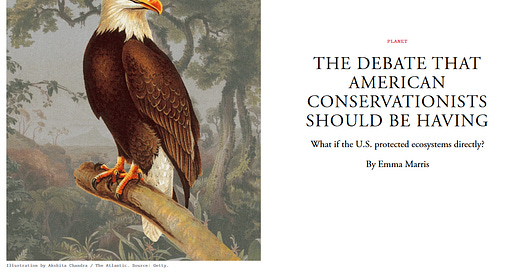How to Protect "Endangered" Species Before They Become Endangered
If we take care of ecosystems all around us, then most species will not become endangered in the first place. Regenerative farming, gardening and landscaping are the key
Article: The Debate That American Conservationists Should Be Having - The Atlantic
Some say the Endangered Species Act, for all the good it may have done, places undue emphasis on the complete extinction of a species, shifting the focus away from maintenance of the habitat on which the species depends.
I agree with this. If the prairie dogs or beavers have been eliminated from 95% of their original range, then they are no longer performing their ecological functions in that range. So they are functionally extinct in places where they used to be but no longer exist. This phenomenon has tremendous implications for ecosystems. Bison are functionally extinct from the Great Plains. Some say their extinction could have contributed to the Dust Bowl in the 1930s.
But if a species is at risk of extinction, then it is already functionally extinct over most of its range. I'm not sure what the Atlantic is proposing, because of the paywall. But if we are going to protect species, we cannot wait until they are on the brink. For my entire life, nature shows have been lamenting extinctions, such as the dodo and the passenger pigeon. But those same shows have not taught us how ecosystems work, in my opinion.
It took Doug Tallamy's crusade to teach us how caterpillars depend on native plants, and birds depend on caterpillars. Take away, or reduce, the native plants, and you have declining bird populations.
Tallamy also taught us the perils of habitat fragmentation. There is a linear relationship between the size of a habitat fragment and its capacity to support populations naturally occurring there. Reduce the size of non-fragmented habitat, and you reduce the population in that exact proportion.
There's enough ecological work to go around and many different perspectives on where to start. I choose to start with soil health, water cycles and with the ability of my home landscape to support bees, butterflies and birds.
That journey has led me to understand how ecological farming could work, via teachers like Gabe Brown (Dirt to Soil) and Mark Shepard (Restoration Agriculture).
If we can get farming to be ecological, then we are addressing these problems at scale, because farming occupies so much land. If we can get farming to be regenerative, then our farms will support bees, butterflies and birds, starting with healthy soil.
Here is a valuable resource that I discovered. This is a link to my slideshow that features a master's thesis by Alexandrea Michels, from South Dakota State University. Pesticides, per Alexandrea Michels - Google Slides.
Here is the masters thesis: Regenerative Agriculture Effects on Invertebrate And Bird Communities And Insect-Provided Ecosystem Services.
Alexandrea studied under Jonathan Lundgren, a truth-telling entomologist who was too honest to be a good fit for the USDA, so he left and started his own research farm. I learned about Lundgren in Dirt to Soil and also from What Your Food Ate, by David Montgomery and Anne Bickle.
Farming can be done ecologically. Those who say we have to destroy the soil, the water and the wildlife to "feed the world" are simply missing the biggest part of the picture.
******
Check out the Water & Climate course, starting in July.
Our Early Bird discount that ends on May 31.
Water & Climate - Biodiversity for a Livable Climate
https://bio4climate.org/course-offerings/water-and-climate/?blm_aid=26405
The untold story of how water drives climate change … what climate models miss about the power of water.





